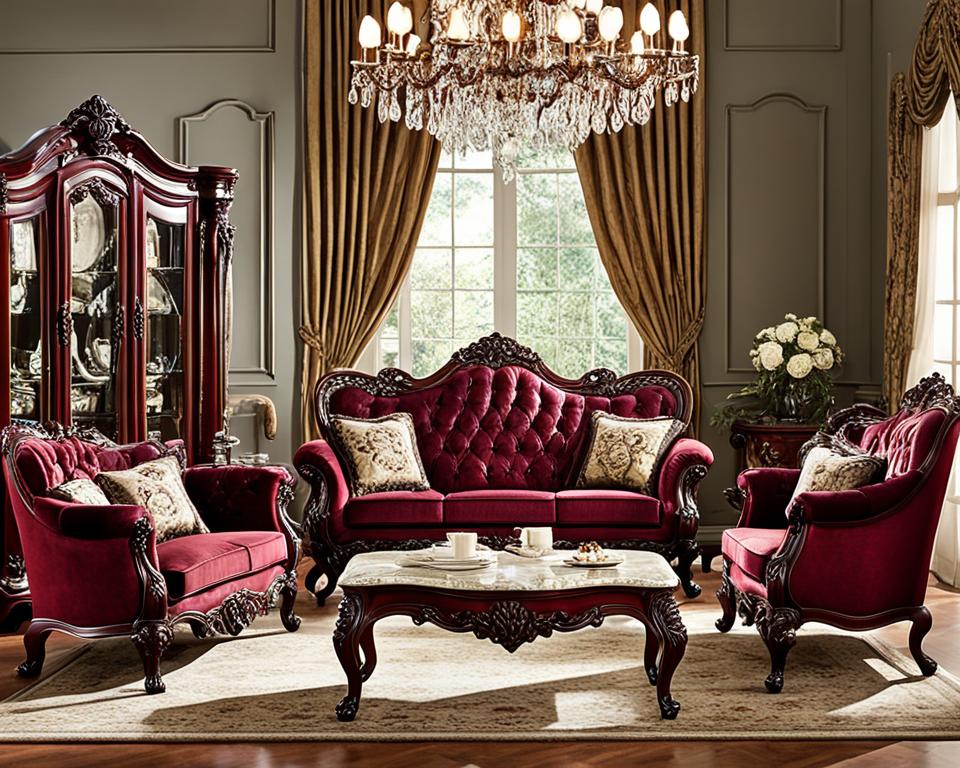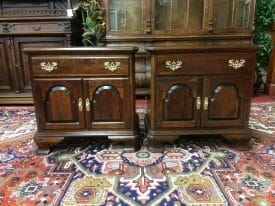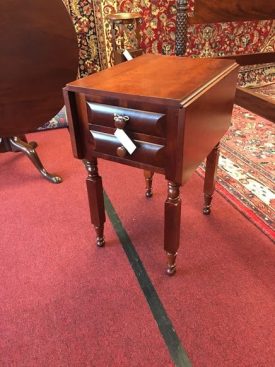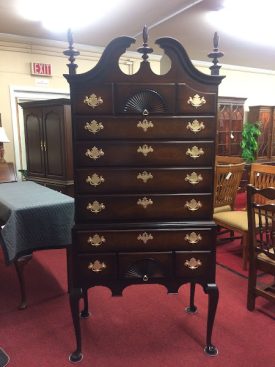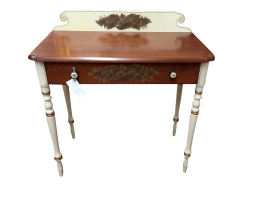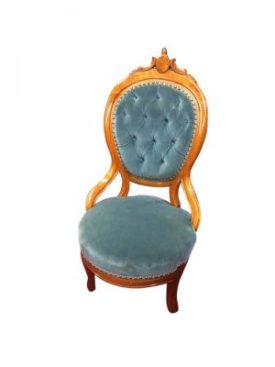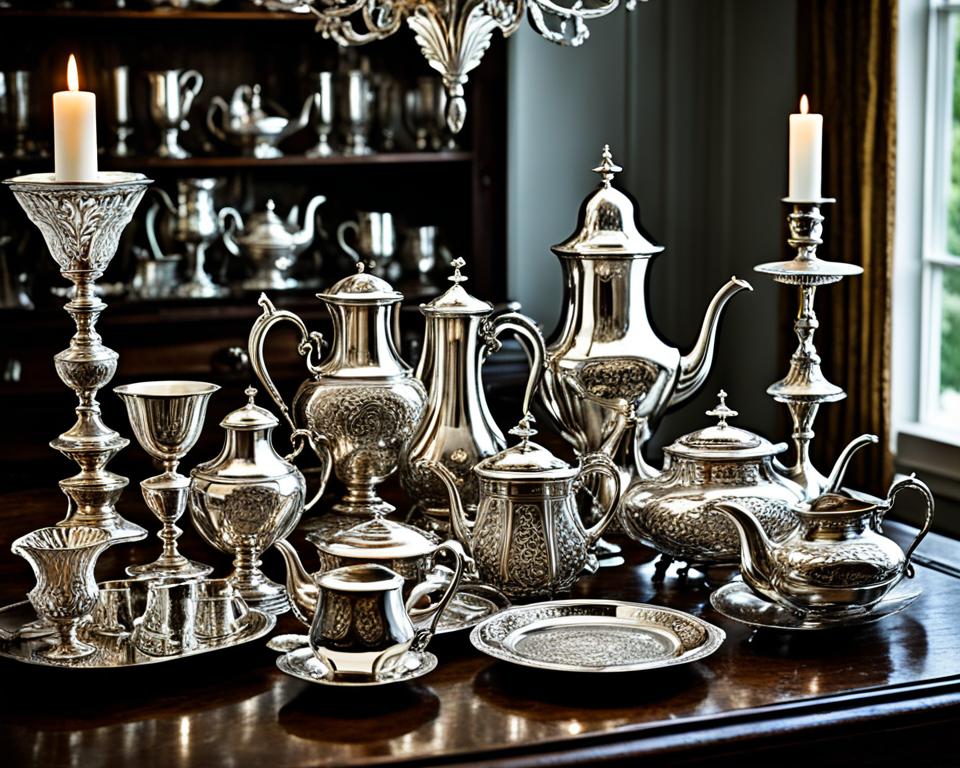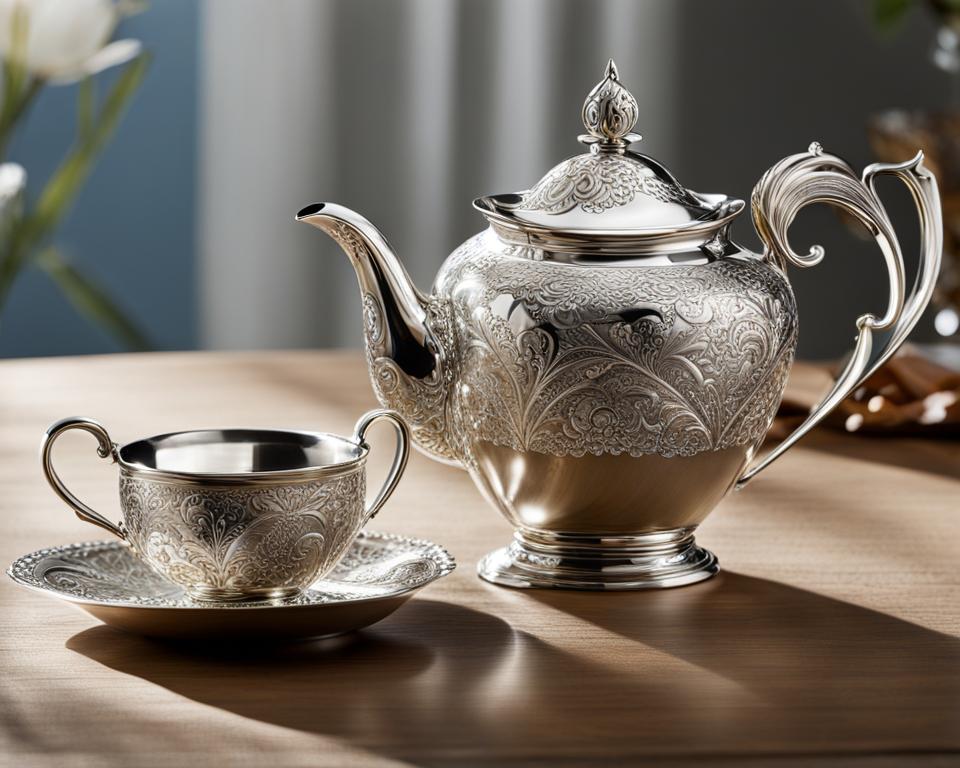The history of English furniture reflects the evolving tastes, aspirations, and socio-cultural dynamics of its time. From the utilitarian simplicity of medieval furniture to the opulence and diversity of Victorian furniture, each era has its own distinct characteristics. This article will explore the traits that define Victorian furniture and its lasting influence on interior design.
Key Takeaways:
- Victorian furniture is characterized by a fusion of styles, including Gothic Revival, Rococo Revival, and the Arts and Crafts movement.
- Victorian furniture ranges from opulent and heavily ornamented pieces to more practical and utilitarian designs.
- The era’s influence can still be seen in various aspects of interior design today.
- Victorian furniture is known for its intricate detailing and use of luxurious materials.
- Incorporating antique Victorian pieces into modern interiors can add a timeless charm.
Medieval Times: Form Follows Function
During the medieval era in England, furniture design showcased functional simplicity. Furniture primarily served a utilitarian purpose, focusing on practicality rather than extravagant aesthetics. Made from durable woods like oak, chestnut, and elm, medieval furniture was built to withstand the test of time.
Tables in this period were rudimentary, featuring collapsible legs for easy storage and transport. These tables often served as multipurpose surfaces for dining, working, and social gatherings. With their simple yet sturdy construction, they exemplified the notion that form follows function.
Medieval Furniture Characteristics:
- Durable woods such as oak, chestnut, and elm
- Functional simplicity
Chairs, on the other hand, were a luxury reserved for the nobility. Their design reflected a hierarchical society, with a heavy and rigid structure symbolizing power and authority. Upholstery was not typically used during this time, as comfort took a backseat to the overall durability and stability of the furniture.
“Medieval furniture embraced the idea that practicality and longevity were key.”
Medieval furniture was crafted with the notion that functionality trumped ornate designs. This emphasis on utility laid the foundation for future furniture styles and influenced the evolution of interior design for centuries to come.
To better understand the characteristics of medieval furniture, refer to the table below:
| Characteristic | Description |
|---|---|
| Materials | Durable woods like oak, chestnut, and elm |
| Design | Functional simplicity |
| Functionality | Focus on practical use |
Image: Medieval Furniture – Alt text: Medieval Furniture Characteristics
The Renaissance Influence: 16th Century
The arrival of the Renaissance in the 16th century marked a significant turning point in English furniture design. Inspired by the artistic movements in Italy and France, Renaissance furniture became more ornate, intricate, and reflective of the growing appreciation for craftsmanship.
Tables during this period featured bulbous legs, exuding a sense of elegance and grandeur. Chairs evolved with turned legs, upholstered seats, and higher backs, providing both comfort and aesthetic appeal. The combination of these elements created a luxurious and regal atmosphere in interior spaces.
The materials used in Renaissance furniture design added richness and depth to its aesthetic. Walnut and oak were the favored woods, known for their durability and natural beauty. The intricate carvings and detailed embellishments further enhanced the visual appeal of these pieces, showcasing the skill and expertise of the craftsmen.
Perhaps the most significant influence of the Renaissance on English furniture design was the shift towards a more refined and decorative style. The attention to detail, use of intricate ornamentation, and incorporation of classical motifs showcased a revival of interest in the arts and humanities.
This period of Renaissance influence had a lasting impact on furniture design, laying the foundation for future styles and movements. The ornate and intricate nature of Renaissance furniture set the stage for the opulence of the Baroque and Rococo periods that followed.
| Renaissance Furniture Characteristics | Renaissance Furniture Design | Renaissance Furniture Materials | Renaissance Furniture Influence |
|---|---|---|---|
| Ornate and intricate | Reflective of the growing appreciation for craftsmanship | Walnut and oak | Laid the foundation for future styles and movements |
| Bulbous legs on tables | Turned legs, upholstered seats, and higher backs on chairs | ||
Jacobean Era: Early 17th Century
In the early 17th century, the Jacobean era brought a unique English touch to furniture design while continuing the influence of the Renaissance. Furniture from this period displayed distinct characteristics, with heavy and geometric designs that exuded a sense of grandeur. Key features of Jacobean furniture included bulbous turnings, strapwork, and intricately carved motifs.
The dominant wood used during the Jacobean era was oak, known for its strength and durability. This choice of material contributed to the robust and enduring nature of Jacobean furniture. Cabinets and chests also gained prominence during this time, serving both practical and decorative purposes.
| Jacobean Furniture Characteristics | Jacobean Furniture Design | Jacobean Furniture Materials | Jacobean Furniture Influence |
|---|---|---|---|
|
|
|
|
The Jacobean era’s furniture designs showcased a fusion of styles, combining the opulence of the Renaissance with distinct English craftsmanship. The influence of Jacobean furniture can still be seen in interior design today, as it continues to inspire designers with its impressive aesthetics and enduring appeal.
Carolean and William and Mary Period: Late 17th Century
The late 17th century witnessed the emergence of two influential periods in English furniture design: Carolean and William and Mary. Both styles brought unique characteristics and aesthetics, reflecting the changing societal attitudes towards comfort and relaxation.
Carolean Furniture Characteristics
Carolean furniture, which evolved from the Jacobean era, retained the weightiness of its predecessor. However, it incorporated more exuberant detailing, showcasing intricate carvings and bold ornamentation. This style embraced a sense of grandeur and opulence, reflecting the flourishing confidence and prosperity of the time.
William and Mary Furniture Characteristics
In contrast, William and Mary furniture embraced a lighter and more graceful aesthetic. Influenced by Dutch and French styles, it featured elegant lines, delicate curves, and exquisite marquetry work. Cabriole legs became a prominent element, adding a touch of sophistication and elegance to the pieces.
Both Carolean and William and Mary furniture designs were crafted using the finest materials available during that period.
| Carolean Furniture Design | Carolean Furniture Materials |
|---|---|
| Exuberant detailing with intricate carvings and bold ornamentation | Sturdy hardwoods like oak and walnut |
| William and Mary Furniture Design | William and Mary Furniture Materials |
|---|---|
| Elegant lines, delicate curves, and exquisite marquetry work | High-quality woods like walnut, oak, and maple |
The Carolean and William and Mary periods left a lasting impact on English furniture design, paving the way for future innovations and styles.
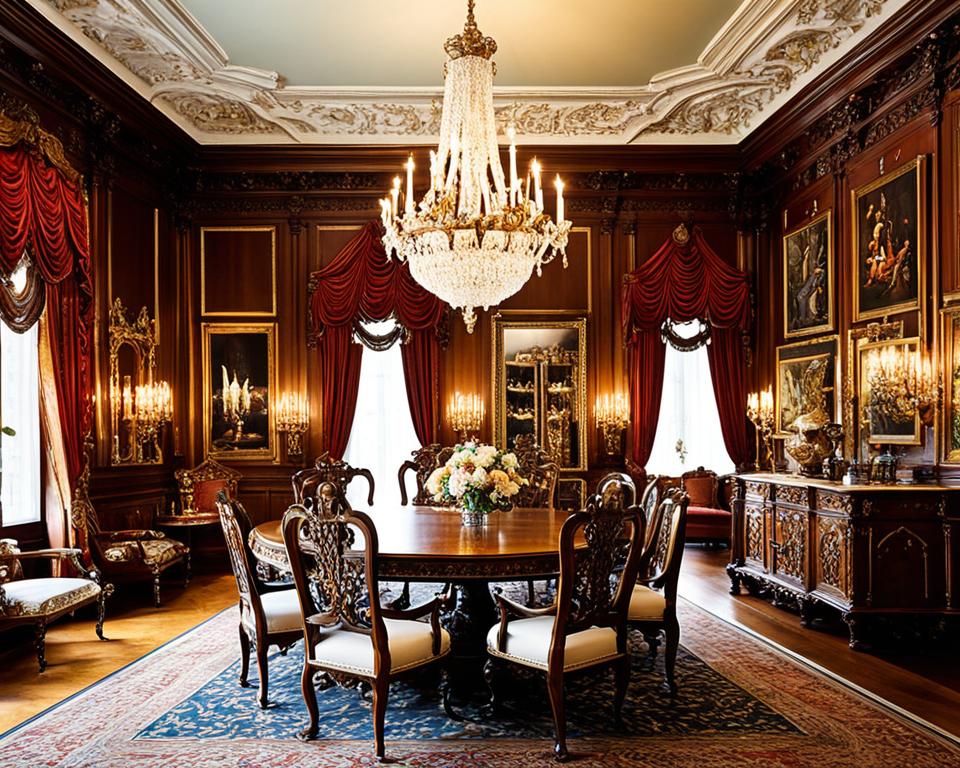
Queen Anne and Georgian Period: Early 18th Century
In the early 18th century, English furniture design experienced a significant shift with the emergence of the Queen Anne and Georgian periods. These eras were characterized by a departure from the elaborate designs of previous periods, giving way to a more refined and restrained aesthetic.
Queen Anne furniture, named after the reigning monarch, Queen Anne of Great Britain, featured elegant and graceful designs. One of the defining characteristics of this period was the use of cabriole legs, which curved outward at the knees and then tapered down to the feet. This style of leg added a sense of sophistication to chairs, tables, and cabinets. Scalloped shells were another prominent feature in Queen Anne furniture, adding a delicate and ornamental touch to the pieces.
The Queen Anne period also witnessed a significant shift in the choice of wood. While oak and walnut had been popular choices in previous periods, mahogany rose to prominence during the early 18th century. Mahogany’s rich, reddish-brown hue and durability made it the preferred material for furniture makers. This transition in wood selection further contributed to the refined and elegant aesthetic of Queen Anne furniture.
Georgian furniture, which followed the Queen Anne period, continued the trend of refined designs. Influenced by classical architecture, Georgian furniture emphasized symmetry, balance, and proportion. Georgian designers drew inspiration from ancient Greek and Roman art, incorporating neoclassical elements into their creations.
The rise of the merchant class during the Georgian period also influenced furniture designs. As prosperity increased, there was a growing demand for furniture that combined comfort and sophistication. Georgian furniture catered to this demand by offering pieces that were both aesthetically pleasing and functional.
In Summary:
The Queen Anne and Georgian periods in the early 18th century marked a shift towards refined design in English furniture. Queen Anne furniture featured cabriole legs and scalloped shells, creating an elegant and graceful aesthetic. Mahogany replaced oak and walnut as the preferred wood choice, adding richness to the pieces. Georgian furniture, influenced by classical architecture and the rising demand for comfort, emphasized symmetry and functionality.
| Queen Anne Furniture Characteristics | Georgian Furniture Characteristics |
|---|---|
| Elegant and graceful designs | Emphasis on symmetry and balance |
| Cabriole legs and scalloped shells | Incorporation of neoclassical elements |
| Use of mahogany as the preferred wood | Growing demand for comfort and functionality |
Chippendale, Hepplewhite, and Sheraton: Mid to Late 18th Century
The mid to late 18th century marked a significant period in furniture design with the emergence of influential designers such as Thomas Chippendale, George Hepplewhite, and Thomas Sheraton. Each designer contributed to the evolution of furniture styles, introducing innovative approaches that shaped the aesthetics and functionality of their creations.
Chippendale Furniture Characteristics:
- Elaborate designs
- Blend of Rococo and Gothic influences
Hepplewhite Furniture Characteristics:
- Favored delicate, tapered legs
- Incorporated neoclassical motifs
Sheraton Furniture Characteristics:
- Embraced straight lines
- Mastered the art of inlay work
During this period, there was also a notable shift towards the creation of diverse furniture pieces. Bookcases and writing desks gained prominence, reflecting a growing demand for functional and versatile furniture.
“The designs of Chippendale, Hepplewhite, and Sheraton left an indelible mark on the history of furniture design. Their unique styles and attention to detail continue to inspire and influence contemporary craftsmen.”
The Legacy of Chippendale, Hepplewhite, and Sheraton
The furniture designs by Chippendale, Hepplewhite, and Sheraton had a profound impact on future generations, with their styles becoming timeless classics that are still revered today. Their innovative approaches to form and ornamentation set new standards for craftsmanship and influenced subsequent furniture movements.
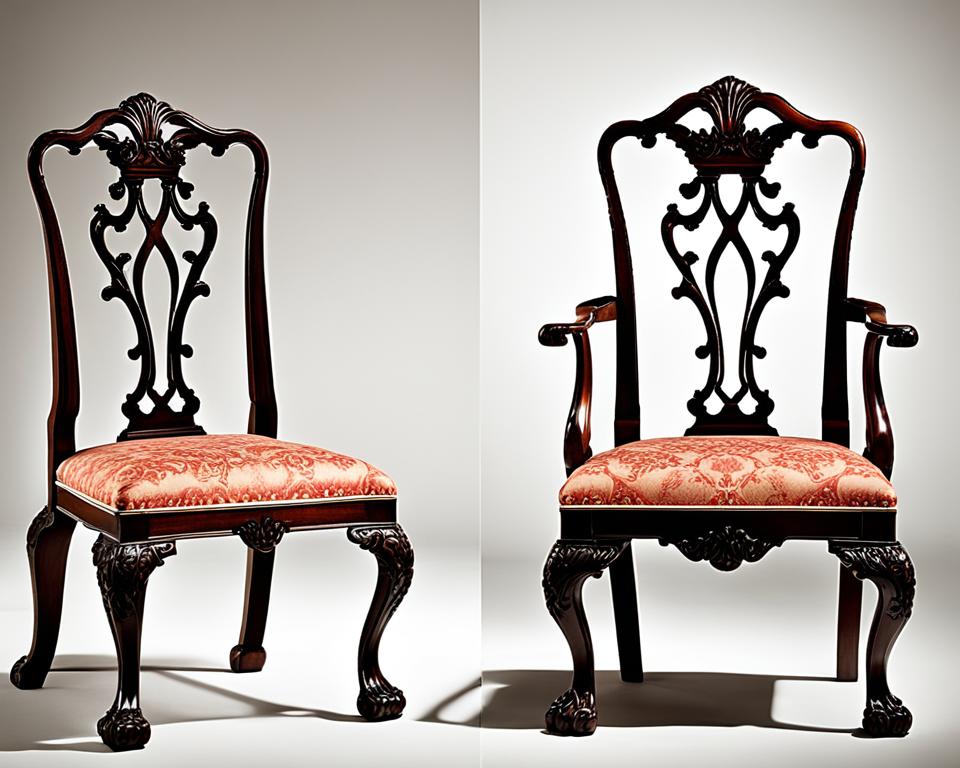
The elaborate designs of Chippendale furniture showcased a blend of Rococo and Gothic influences. Intricate carvings, curvaceous lines, and detailed ornamentation were hallmarks of Chippendale’s style, exemplifying the opulence and grandeur of the era.
Hepplewhite Furniture Design:
Hepplewhite favored elegant and delicate designs, emphasizing neoclassical motifs. His furniture featured tapered legs, clean lines, and refined proportions. Hepplewhite’s designs epitomize the grace and sophistication of the late 18th century.
Sheraton Furniture Design:
Sheraton’s furniture designs embraced simplicity and symmetry. Straight lines, geometric shapes, and intricately crafted inlay work showcased Sheraton’s meticulous attention to detail. His furniture pieces exuded a sense of elegance and understated beauty.
The enduring popularity of Chippendale, Hepplewhite, and Sheraton furniture is a testament to their remarkable craftsmanship and visionary design sensibilities. Whether in traditional or contemporary interiors, their creations continue to bring timeless charm and sophistication to any space.
Regency Era: Early 19th Century
The Regency era brought forth a distinctive style in furniture design, departing from the strict neoclassicism of the Georgian period. This period, influenced by classical aesthetics, introduced a sense of elegance and sophistication to interior spaces. Regency furniture, characterized by its clean lines and symmetrical forms, sought inspiration from Greek and Roman motifs.
The materials used in Regency furniture reflected the desire for opulence and luxury. Rosewood, with its rich and dark hues, was a favored choice, adding a touch of grandeur to the pieces. Ebony, known for its strength and durability, was also commonly incorporated, further enhancing the elegance of Regency furniture.
One notable feature of Regency furniture design is the mastery of lines and curves. Geometric shapes were often softened with subtle curves, creating a balanced and harmonious visual appeal. The attention to detail and craftsmanship during this era resulted in furniture pieces that exuded a sense of refinement and grace.
“Regency furniture signifies an era of timeless beauty and grandeur, drawing inspiration from classical architecture and design. The clean lines, Greek and Roman motifs, and the use of rosewood and ebony showcase the elegance and sophistication of this period.”
The Regency era’s influence on interior design extends beyond furniture. The fusion of classical elements with contemporary sensibilities set the stage for the development of diverse design styles. The timeless appeal and enduring popularity of Regency furniture characteristics continue to inspire designers and homeowners alike.
The Key Characteristics of Regency Furniture:
- Elegant and symmetrical designs
- Incorporation of Greek and Roman motifs
- Clean lines with subtle curves
- Use of high-quality materials like rosewood and ebony
- Meticulous craftsmanship and attention to detail
Victorian Era: Mid to Late 19th Century
The Victorian era marked a period of remarkable diversity and innovation in furniture design. Mass production and the utilization of new materials opened doors to a fusion of styles, including the Gothic Revival, Rococo Revival, and the Arts and Crafts movement. Victorian furniture encompassed a wide range, from opulent and heavily ornamented pieces to more practical and utilitarian designs. The influence of the Victorian era is still evident in various aspects of interior design today.
During the Victorian era, advancements in manufacturing techniques allowed furniture to be produced on a larger scale than ever before. This led to a wider availability of furniture, making it accessible to a broader range of people. Additionally, the expansion of the railway system facilitated the transportation of furniture across long distances, further contributing to its popularity.
The Victorian period saw a mix of traditional and innovative design elements. Victorian furniture often featured intricate carvings, elaborate detailing, and rich ornamentation, reflecting the era’s fascination with ornament and its romantic notions. The furniture was crafted using a variety of materials, such as mahogany, walnut, rosewood, and oak, offering different textures and aesthetics.
“The Victorian era was characterized by a sense of grandeur and an emphasis on intricate details and decoration. This is evident in the opulent and ornate nature of Victorian furniture.”
Victorian furniture design was greatly influenced by societal trends and cultural movements. The Gothic Revival style, for example, drew inspiration from medieval architecture and featured pointed arches, intricate tracery, and richly decorated surfaces. The Rococo Revival style, on the other hand, embraced the elegance and playfulness of the 18th-century French Rococo period, with its curvaceous lines, elaborate scrolls, and floral motifs. The Arts and Crafts movement, led by influential figures such as William Morris, emphasized simplicity, craftsmanship, and the use of natural materials.
Victorian furniture catered to a wide range of needs, from lavish pieces for the upper class to more practical and economical designs for the middle class. The era witnessed the rise of innovative furniture forms such as the chaise longue, the ottoman, and the wardrobe. These new pieces provided functionality alongside their aesthetic appeal.
Influence on Interior Design
The impact of Victorian furniture on interior design is undeniable. Aspects of Victorian design continue to be admired and incorporated into modern interiors, adding a touch of elegance and nostalgia. The ornate detailing, intricate carvings, and rich finishes of Victorian furniture create a sense of luxury and grandeur. Victorian-inspired elements can be found in traditional and eclectic interiors, as well as in contemporary spaces that showcase a fusion of old and new.
“The enduring influence of Victorian furniture in interior design speaks to its timeless appeal and the enduring charm of its intricate craftsmanship and ornamental features.”
Today, Victorian furniture continues to be sought after by collectors, antique enthusiasts, and those with a penchant for vintage aesthetics. The combination of craftsmanship, historical significance, and unique design elements makes Victorian furniture a valuable addition to any interior.
Louis XVI Furniture Characteristics
The Louis XVI furniture style emerged during the late 18th century in France and was deeply intertwined with the reign of Louis XVI. This period, also known as the Neoclassical era, represented a departure from the extravagant Rococo style that preceded it. Louis XVI furniture embraced elegant simplicity, refined details, and a sense of balance.
One of the defining characteristics of Louis XVI furniture is its intricate detailing and precise craftsmanship. Artisans paid meticulous attention to every element, from the delicate carvings and ornamental motifs to the use of luxurious materials.
The style reflects not only the prevailing aesthetic tastes but also the socio-political circumstances of the time. The Neoclassical ideals that influenced Louis XVI furniture were inspired by the archaeological discoveries of ancient Greece and Rome. This fascination with the classical past was also a deliberate political statement, aligning with the movement towards reason and enlightenment.
Elegance and symmetry are hallmarks of Louis XVI furniture design. The lines are clean and restrained, with a focus on geometric shapes and straight legs. The influence of ancient Greek and Roman architecture can be seen in the fluted columns, tapered legs, and restrained ornamentation.
Materials used in Louis XVI furniture were carefully chosen to enhance the sense of luxury. Fine woods such as mahogany, walnut, and oak were favored, often adorned with exquisite veneers or marquetry. Gilding and decorative accents in bronze or ormolu further elevated the opulence of the pieces.
Louis XVI furniture had a profound influence on the world of interior design. It sparked a renewed interest in classical forms and aesthetics, giving rise to a revived appreciation for craftsmanship and fine details. The style gained popularity not only in France but also across Europe, leaving a lasting legacy on furniture design and inspiring subsequent movements.
Antique Decorating: Incorporating Vintage Pieces
Incorporating antique furniture into your interior design can add a unique and timeless charm to your space. Antique pieces have a rich history and carry a sense of nostalgia that can create a warm and inviting atmosphere. Whether you’re a vintage enthusiast or simply looking to add character to your home, here are some tips on how to decorate with antique furniture:
- Mix antique and contemporary pieces: Combine the old and the new to create a harmonious blend of styles. Pairing antique furniture with modern elements adds visual interest and creates a balanced look.
- Focus on statement pieces: Antique furniture often has intricate details and unique craftsmanship that make them stand out. Use these statement pieces as focal points in your space, allowing them to take center stage.
- Play with colors and patterns: Antique furniture comes in a variety of colors and patterns, allowing you to create a vibrant and eclectic look. Experiment with different combinations to find the ones that complement your existing decor.
- Embrace patina: The natural wear and tear that comes with age add character and authenticity to antique furniture. Embrace the patina and imperfections, as they tell a story and give your space a lived-in feel.
- Balance functionality with aesthetics: While antique furniture is undoubtedly beautiful, it’s essential to consider its functionality as well. Ensure that the pieces you choose serve a practical purpose and meet your everyday needs.
By following these decorating tips, you can create a space that seamlessly incorporates vintage pieces, adding depth and personality to your home décor.
Conclusion
The evolution of English furniture from medieval times to the Victorian era showcases the dynamic interplay between artistic expression, technological advancements, and societal shifts. Victorian furniture, with its diverse styles and influences, continues to inspire and captivate us today. By understanding and appreciating the characteristics of Victorian furniture, we can infuse our spaces with the elegance and grandeur of a bygone era.
Victorian furniture is characterized by its ornate designs, intricate details, and rich materials. From the opulence of Gothic Revival to the delicate motifs of Rococo Revival, Victorian furniture encompasses a wide range of styles that catered to various tastes and preferences of the time. The use of new materials and mass production techniques allowed for the creation of innovative designs that transformed interior spaces.
As we look back at the Victorian era and its impact on furniture design, we can draw inspiration from its timeless elegance. Incorporating Victorian furniture into our modern homes adds a touch of sophistication and nostalgia. Whether it’s a beautifully carved Victorian chair or an ornate sideboard, these pieces create a sense of history and bring a unique story into our living spaces.
Final Thoughts on Victorian Era Furniture:
- Victorian furniture reflects the diverse styles and influences of the era.
- It combines opulence, intricate detailing, and rich materials.
- Incorporating Victorian furniture adds elegance and nostalgia to modern spaces.
- By appreciating and understanding the characteristics of Victorian furniture, we can create a timeless and sophisticated interior design.
FAQ
What are the characteristics of Victorian furniture?
Victorian furniture is known for its diverse styles and influences, ranging from opulent and heavily ornamented to more practical and utilitarian. It incorporates elements from Gothic Revival, Rococo Revival, and the Arts and Crafts movement.
How does Victorian furniture influence interior design?
Victorian furniture has a lasting influence on interior design, as it showcases a remarkable diversity and innovation in furniture design. Its influence can still be seen in various aspects of interior design today.
What are the characteristics of Medieval furniture?
Medieval furniture was characterized by functional simplicity and primarily served a utilitarian purpose. It was made from durable woods like oak, chestnut, and elm, and featured rudimentary tables and heavy, rigid chairs.
How did the Renaissance influence English furniture design?
The Renaissance brought about a transformation in English furniture design. Influenced by Italian and French styles, furniture became more ornate and intricate, featuring bulbous legs, turned legs, upholstered seats, higher backs, and the use of walnut and oak.
What defines Jacobean furniture from the early 17th century?
Jacobean furniture is characterized by heavy and geometric designs, with bulbous turnings, strapwork, and carved motifs. Oak remained the dominant wood, and cabinets and chests gained prominence.
What are the characteristics of Carolean and William and Mary furniture from the late 17th century?
Carolean furniture retained the weightiness of Jacobean pieces but added more exuberant detailing, while William and Mary furniture embraced a lighter and more graceful aesthetic with elements like cabriole legs and marquetry work. Both styles reflected changing societal attitudes towards comfort and relaxation.
How did the Queen Anne and Georgian periods influence furniture design?
The Queen Anne and Georgian periods brought about more refined furniture designs with cabriole legs, scalloped shells, restrained ornamentation, and a shift towards the use of mahogany. The rise of the merchant class also influenced designs, making prosperity and comfort more attainable.
Who were influential furniture designers in the mid to late 18th century?
Thomas Chippendale, George Hepplewhite, and Thomas Sheraton were influential furniture designers in the mid to late 18th century. Chippendale’s designs were elaborate and a blend of Rococo and Gothic influences, Hepplewhite favored delicate, tapered legs and neoclassical motifs, while Sheraton embraced straight lines and inlay work.
What defines furniture from the Regency era in the early 19th century?
Furniture from the Regency era featured Greek and Roman motifs, clean lines, symmetry, and the use of luxurious materials like rosewood and ebony.
What are the characteristics of Louis XVI furniture?
Louis XVI furniture is characterized by intricate detailing and precise craftsmanship. It reflects Neoclassical ideals, elegance, symmetry, and the use of luxurious materials.
How can vintage furniture be incorporated into interior design?
Antique and vintage furniture can add a unique and timeless charm to interior design. Some tips for incorporating vintage pieces include mixing them with contemporary furniture, focusing on statement pieces, playing with colors and patterns, embracing the patina of aged furniture, and balancing functionality with aesthetics.

